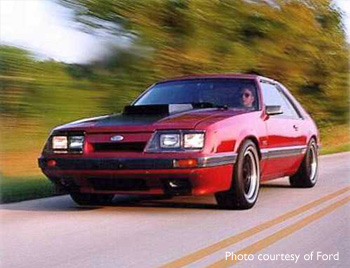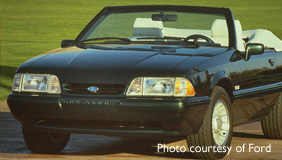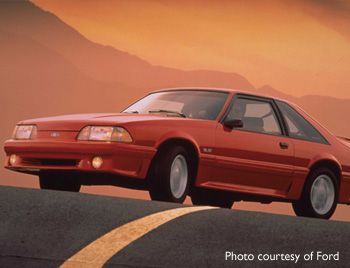Ford Mustang
THIRD GENERATION FORD MUSTANG: 1979 - 1993
The third generation Mustangs was produced in 1979 up to 1993. It was assembled in Dearborn, Michigan with three body styles – 2-door convertible, 2-door coupe and 3-door hatchback. With the new Ford Fox platform, the company featured six types of engines – 2.3 L I4, 2.3 L Turbocharged I4, 3.3 I6, 3.8 L Essex V6, 4.2 L V8 and 302 cu in Windsor V8 – all with 15.4 gallons fuel capacity.
1979 Mustang
Compared to the earlier Mustang, the 1979 models were longer and taller. However, it was 200 pounds lighter than the Mustang II. Engine options included the 2.3L 4-cylinder engine, 2.8L V6, 2.3L engine turbo, 3.3L inline-6 and 5L V8. As the first model for the Fox platform, the 1979 Mustangs were visually more “European” and less traditional in terms of styling features.
 1980 Mustang
1980 Mustang
With the next Mustang in the Fox platform, Ford dropped the 302 V8 engine and offered a 255-cubic inch V8 engine, which boasts up to 119 horsepower. The company wanted to offer an engine that was both economical and sporty. However, many Mustang fanatics found the new engine to be underpowered for racing. In addition, the 2.8L V6 engine was replaced by a 3.3L inline 6 engine.
1981 Mustang
Due to the new U.S. emissions & safety standards, the 1981 Mustang faced additional engine changes. The 2.3 L engine with turbo was dropped from the lineup, while the 255 cu in V8 engine was revamped to produced exactly 115 horsepower, instead of 119 hp it previously produced. Because of this, consumers noticed a decrease in power output on all Mustangs equipped with V8 engines.
1982 Mustang
For critics and Mustang fans, 1982 was the year Ford regained the Mustang appeal by bringing back its original power. Ford brought the Mustang GT back to the lineup, gave way to the return of the T-top option and offered the 5.0L V8 engine again. This time, the V8 engine was capable of producing up to 157 horsepower. The 1982 Mustang also featured an improved exhaust system, which made the 1982 models one of the fastest cars in the U.S. during its time.
1983 Mustang
Since 1970s, Ford has not been producing Mustang convertibles. This changed in 1983 when the Mustang was made available in convertible option. In addition, the mustang GT V8 engine increased in power, producing up to 175 horsepower. In fact, the 1983 model was so admired that the California Highway Patrol bought 400 units, which were used in high-speed pursuits.
1984 Mustang
In 1984, Ford introduced the special edition Mustang SVO, assembling only 4,508 units. It featured a turbocharged 2.3L inline 4-cycline engine, which was capable of producing 210 lb-ft of torque and up to 175 horsepower. Although the Mustang SVO was a powerful model, not many consumers were able to afford its $15,970 tag price. However, Ford also released its 20th anniversary Mustang made as a GT model that featured a V8 engine with Canyon red interior and Oxford white exterior.
 1985 Mustang
1985 Mustang
1985 was the year the 5.0 High Output (HO) motor was introduced as an effort to improve its engine lineup. It was capable of producing 210 horsepower even with a manual transmission. Since the Mustang SVO was still offered, a total of 1,515 units were produced.
During the late 1985, Ford revamped the SVO and released 439 units. These models were able to output up to 205 horsepower and 240 lb-ft of torque, making them a popular car admired by Mustang enthusiasts.
1986 Mustang
Ford dropped the carburetor and introduced the first 302 cu in sequential multi-port fuel injection V8 engine, which can produce 225 horsepower. 1986 was the last year Ford produced Mustang SVOs – an estimated of 3,382 units were manufactured. Only minor changes, such as horsepower reduction from 205 to 200 hp and addition of a third-brake light were made to the SVO.
1987 Mustang
Ford completely revamped the 1987 Mustang to become aerodynamic in design. Being its first major redesign since 1979, the Mustang experience a heavily restyled interior and exterior. The new 5.0L V8 engine can now produce up to 225 horsepower. Since Ford dropped the V6 engine for 1987, engine options for the Mustang was the V8 engine and the 2.3L 4-cyliner fuel-injected motor. Ford also stopped production for the Mustang SVO, but produced a new special edition SVT Cobra (Special Vehicle Team), which was equipped with a 302 cu in V8 engine that can produce 280 lb-ft of torque and 235 horsepower.
1988 Mustang
For 1988, the Mustang GT became one of the most popular Mustangs ever produced with over 68,000 units produced for 1988 alone. The production of T-tops was discontinued early in 1988.
1989 Mustang
Ford produced all 1989 Mustangs with a new mass air system. Celebrating its 25th year, the Mustang was produced with a Mustang Pony inscription with the words “25 Years” placed on the dash. These special edition Mustangs were manufactured from April 17, 1989 to April 17, 1990.
1990 & 1991 Mustang
The 25th Mustang Anniversary was extended up to 1990, releasing 2,000 limited edition jet-black Mustangs. Ford also introduced the first airbag for driver’s side as standard equipment. In 1991, Ford increased the horsepower of all base Mustangs by equipping the vehicle with 105 hp twin-plug 4-cylinder engine. Plus, Ford features all V8 units with 5-spoke 16x7-inch cast aluminum wheels.
 1992 Mustang
1992 Mustang
A limited edition Mustang was released in the late 1992 production year in an effort to boost consumer enthusiasm because the sales were decreasing. However, only a few red convertible (with special rear spoiler) limited editions were released. In 1992, the Mustang LX that featured 5.0L V8 engine with a scaled down body outsold all other Ford models combined.
1993 Mustang
In 1993, Ford’s Special Vehicle Team (SVT) produced another limited edition SVT – the SVT Mustang Cobra and the A Cobra R version that used the same Cobra engine, which was developed as a complete racing engine. Even though the 1993 models were without a stereo and air conditioning, it was sold out completely before production.